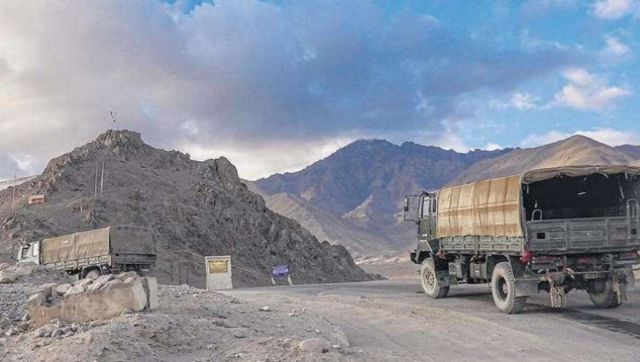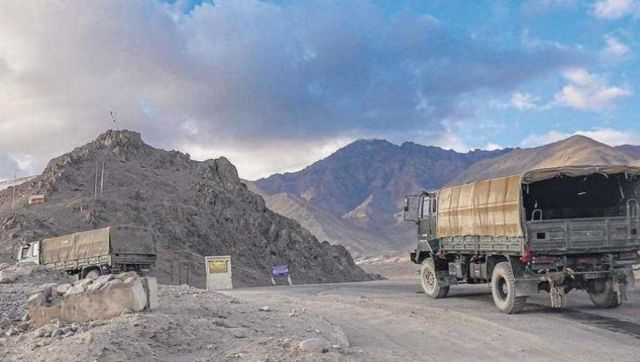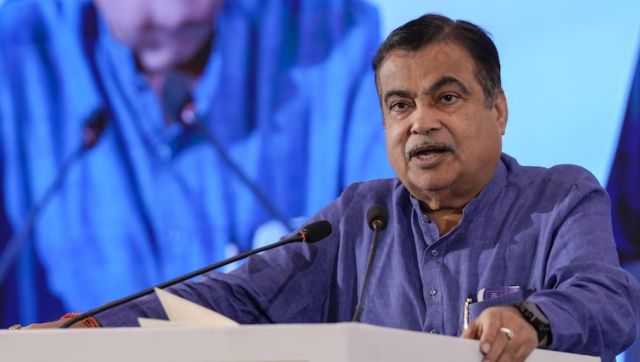Editor’s Note: A network of 60 reporters set off across India to test the idea of development as it is experienced on the ground. Their brief: Use your mobile phone to record the impact of 120 key policy decisions on everyday life; what works, what doesn’t and why; what can be done better and what should be done differently. Their findings — straight and raw from the ground — will be combined in this series, Elections on the Go_, over a course of 100 days._
Read more articles from the series here
***
Singara: Thunder rumbles in the distance and heavy dark clouds loom in the sky but they do little to deter Budbori Payeng and Lalita Payeng from continuing to maneuver their axes to break down logs into neatly-chopped wood in rapid strokes. “It has started already,” says Lalita, “Before the rains, we must stock enough firewood to sustain throughout these months, until the monsoon is over.”
The Singara village in Assam, adjacent to the rivers Singara and Ranganadi gets submerged every year and the water refuses to recede even after the monsoon is over, as released water from Ranganadi reservoir also add to the woes. “Water comes rushing from the Singara river nearby and the strong current takes along everything in our houses — firewood, utensils, food, lanterns. It has been so long that we have been living like this. Our fields are no longer cultivable as they are deluged for the entire year; crops are destroyed before we can harvest them,” Budbori Payeng tells us while directing our attention to the rice planted in their land of less than an acre. “This is one variety of rice that grows only in deep water, but we cannot rely upon its produce as it is not preferred in the market.” The river water has already found its way to the nearby fields. “The water will breach the road and enter our homes. We travel to raised roads at the T-point or embankments on our broken boat during the floods,” says Lalita, adding that livestock also faces huge distress.
Several metres away, their neighbour, Dhenuram Narah, has a similar tale to tell. “Every year, floods wash away our cows, goats and pigs. We may shift to relief camps, but it is difficult to provide them food and shelter. If they survive but fall sick, no one comes to treat them and they eventually die. The April rains have started, and until January, the water continues to stand in our fields and courtyards. This means we cannot grow anything here and often end up working for others even though we are land owners,” says the 67-year-old.
In July 2018, there was a sudden deluge in the Singara river which caused massive inundation of more than 50 villages of Nowboicha Revenue Circle in Lakhimpur district. According to reports, the river overflowed after heavy rains and breached a PWD road which led the water into the villages blocking the NH-15 (Lakhimpur-Arunachal Pradesh) for four days. Residents allege that their miseries were neglected by the government, which failed to set up any relief camp. Again, a few days later, water from the Ranganadi reservoir spilled and resulted in breaching of an embankment and flooded the road between NH 15 and the rail bridge over Ranganadi river. People of North Lakhimpur have serious grievances against the North Eastern Electric Power Corporation Limited (NEEPCO), who, they claim, open the Ranganadi reservoir gates without warning and cause loss of lives and property.
In the bordering villages of Majuli, residents say that they spend the better part of the year battling the waters but more than the flood, it is erosion which has ruined lives of millions of people. “The flood here is so routine an affair that it’s almost like we are born in the waters. We can live with the flood, swimming and rowing but who will give us back our lands lost to the river? There is no embankment to protect our village from the river. We don’t have any crop fields left to cultivate, no proper house to live, everything has been swallowed by the river,” said Rameshwar Pameng of Alimur Mising Gaon.
Rameshwar Pameng recalls the devastating floods of 1988, when all the embankments and elevated roads were under water and it has been since then that they are fighting for help. Although a few villages were relocated in the year 1992, after that, till date no one has been shifted, neither provided any shelter or monetary help. In more than 100 villages in the Majuli district, people live on roads in makeshift houses, supported by bamboo poles 4-5 feet high (called Sang Ghor). The river water continues to flood their homes, which are submerged for months during monsoon.
Wrath of the Brahmaputra
In 2018, more than 4 lakh people in Assam were affected and 46 died after severe floods hit the region following torrential rains. The Brahmaputra river, which descends from a height of 2,450 meters above sea level in the Himalayas, flows through Assam along with its many tributaries and regularly changes its course. The braided river means life to the people of North East India and Bangladesh, as it gifts fertile soil to the valley, helping in agricultural and marine farming and is also a friend of the fisherfolk. But the river is as feared as it is loved.
Every year, the Brahmaputra and 33 of its tributaries cause catastrophic floods in the Brahmaputra valley, Barak valley and also in neighbouring Bangladesh. The valley receives an average annual rainfall of 220 centimetres. The southwest monsoon brings heavy precipitation from May to October, causing the Brahmaputra and its tributaries to overflow. The river Brahmaputra contributes to significant amount of sediment load, which makes the Brahmaputra valley prone to flooding. Over the past years, a considerable amount of land in the region has been wiped out, with Majuli facing the worst kind of erosion. Temporary relief camps and materials can never be sufficient for the millions affected by such a disaster every year and effective measures for control and protection of lives and land have been a dire necessity. The Centre had proposed dredging along the length of the river after the disastrous flood of 2017 but no relief has come of it.
Dhenuram Narah says the government and district authorities have done nothing to change their lives. The problem has existed for over 20 years now. Poll promises are made, but even after four-five elections, the situation remains grim in the village. “Do they consider our lives to be of any value,” he asks.
“Government officials and politicians remember us during elections, only to forget us soon after. We heard that they are giving cooking gas to women, but have a look at us. We still cook food on earthen stoves using firewood, and during floods, when our floors remain deluged, even cooking food becomes impossible,” complains Budbori Payeng. For the Payeng family, all that is earned throughout the year needs to be spent on repairing their homes and buying essentials that are washed away again and again.
In places like these, which have no urban pockets and where agriculture is still the major economic activity of almost all households, loss of cultivable land, plantations and farm animals have huge social and economic ramifications. The state’s disaster management authority, which was notified in 2007 and became functional in 2010, is meant to build capacity for disaster response at the lowest levels. Project Officer of the Assam State Disaster Management Authority (ASDMA) in Lakhimpur, Papori Borah, maintains that proper precautionary measures have been taken in the district and by coordinating with NEEPCO, the district authorities will try to prevent harm caused by water from the Ranganadi river. She added that after the floods last year, they recognized the loopholes and accordingly initiated projects like community-based warning system by installing sirens which can alert villagers when water crosses danger mark. Her counterpart in Majuli, Dibya Jyoti Saikia, says that significant work has been done in the past few years to control floods and minimise loss. He said that all the project work undertaken in the past year has been completed or is nearing completion, and this year, the monsoon is unlikely to cause widespread damage.
Such claims are however refuted by Moneswar Kutum, the village headman of Sumoimari Gaon, a village critically affected by erosion happening every year. “Ten years ago, this village stretched for kilometres from here (towards the river), but successive floods kept pushing its boundary inward with hundreds of acres of land destroyed by the river. Small embankments are made here and there in the name of control measures, but they are not planned properly,” he says.
Pointing to construction work just 50 metres from his home towards the river, Kutum narrates how the government had felled hundreds of trees on his land without his permission and initiated work for construction of an embankment. The work was left incomplete due to a dispute between the government and the construction company. “Whatever clashes the powerful people have, it is us who always suffer. We have shifted thrice in the past ten years; our homes and fields are already devoured by the river. Over 240 families from this village and those from other villages in Majuli continue to reside along the ridges.”
Rameshwar Pameng says, “The situation becomes horrifying; we only stick to our children and family in those awful days. We have lost everything and yet were never provided any monetary help to revive. You will never visit the island if you see what happens here in the months when it is flooded.”
According to a recent report by NENOW, RTI replies have revealed that the Brahmaputra Board had paid Rs 31,48,326 to charter an aircraft for four days in December 2017, when Minister of Water Resources, River Development and Ganga Rejuvenation Nitin Gadkari had come with his family to lay the foundation stone for Brahmaputra Board complex in Majuli and spent a luxurious new year in the state. The Brahmaputra Board is supposed to carry out surveys and investigations in the Brahmaputra and Barak Basin and to prepare a master plan for the control of floods, bank erosion and improvement of drainage and activities connected therewith.
The current chief minister Sarbananda Sonowal convincingly won the Lakhimpur Lok Sabha seat in 2014, before he contested Assembly elections in 2016 from Majuli and was elected as the chief minister of Assam. Does belonging to the chief minister’s constituency give Lakhimpur an edge over those from other constituencies? “When Sarbananda Sonowal approached us for the previous Lok Sabha election in 2014 and then the Vidhan Sabha election in 2016, he assured us that if we vote for him, he would solve the problem of erosion in Majuli and help us with relocation, establishment or jobs . But nobody has received any benefits,” says Rameshwar Pameng.
Pameng also expressed anger over the proposed Citizenship (Amendment) Bill 2016. The Bill, which was passed in the Lok Sabha on 8 January this year, facilitates granting of citizenship to illegal migrants belonging to the Hindu, Sikh, Buddhist, Jain, Parsi or Christian religious communities from Afghanistan, Bangladesh or Pakistan. “Is there any place for them to come and settle here? If there is, why isn’t it being given to us?” he asks.
Moneswar Kutum adds, “The government knows about our situation. The previous Tarun Gogoi-led Congress Government told us that they do not have any provision for resettlement and we will have to continue living here. It has become an annual event now, but no one, even once, talks about a permanent solution to this problem.”
Meanwhile, after the current government came to power, yoga guru Baba Ramdev has been allocated 1,200 acres and 148 acres of land in Chirang and Balipara respectively to set up Patanjali factories in Assam.
The voters here exercised their franchise during the first phase of polling. Congress president Rahul Gandhi had visited Lakhimpur a week before that and addressed a rally in the presence of thousands of supporters, but skipped any mention of the victims of this annual calamity. Repeated betrayals have left the people shattered and elections do not mean much anyway for people in these afflicted areas. Perhaps the 65 percent voter turnout that was recorded here is a good figure under the circumstances.
(The author is a Pune-based freelance writer and a member of 101Reporters )


)




)
)
)
)
)
)
)
)